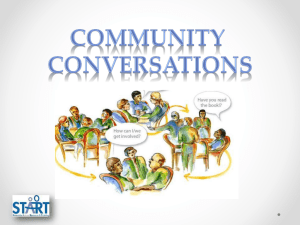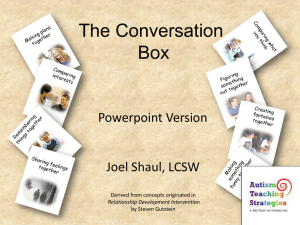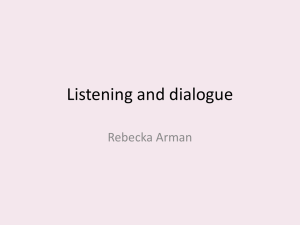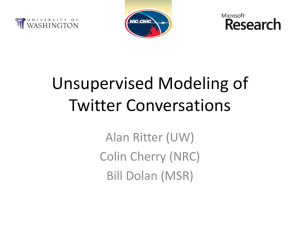Handling Difficult Conversations
advertisement
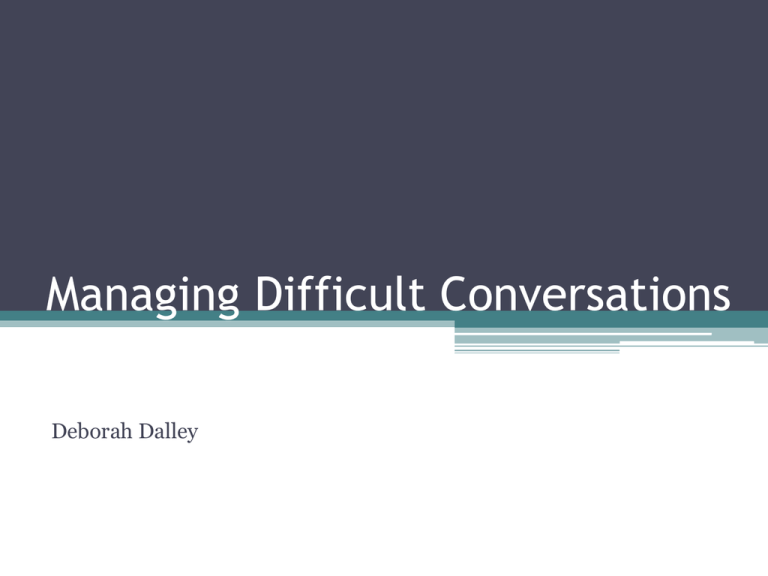
Managing Difficult Conversations Deborah Dalley Key areas for today Recognise what makes some conversations difficult Identify the questions to ask when preparing for a difficult conversation Use a structured framework to conduct the conversation Explore different ways to deal with defensive reactions ‘Our lives begin to end the day we become silent about the things that matter the most’ Martin Luther King What does difficult mean? Not easy Hard to be done Arduous Demanding considerable effort A conversation is a talk between two or more people in which thoughts, feelings and ideas are expressed, information is exchanged and questions are asked and answered. Think back to any conversations that you have had (or avoided) that you considered difficult and discuss: • What were they about? • What made them difficult? These situations usually have several things in common: There are high stakes and potential consequences There are opposing viewpoints There is uncertainty about how the conversation will play out There is often historical baggage There are powerful emotions involved What were the main reasons for putting it off? • • • • • • • Didn’t want to create a bad atmosphere To avoid confrontation Didn’t know how to say it Worried about the reprisals Thought it might make the situation worse Didn’t want to upset someone Other reasons - lack of back up, lack of time 29% 18% 16% 11% 11% 8% 7% Did the issue: • Resolve itself • Get worse • Stay the same 4% 43% 49% The other 4% reported that someone else had tackled the issue Have you ever: Sent an e-mail or text to someone because you did not want to say something face to face. Delivered a message to the whole team or group that was really intended for one person. Complained or gossiped about someone’s behaviour but not spoken to them directly about it. Asked a leading question in the hope that someone else will raise the issue that you want to talk about. Incident Repeated Incident Pattern Relationship Incident Notice it Repeated Incident Give feedback Pattern Initiate a conversation Relationship Internal dialogue Internal dialogue Mental picture Internal dialogue Mental picture Your body’s reaction Preparation What is happening? What are my reasons for having this conversation? What has contributed to the issue? What do I want? Evaluate and Explain Translate and Label Observable Behaviour What is happening? She is really disorganised He is so behind with his research and just isn’t doing enough He lets himself and the team down with his attitude to work She is so disorganised He is so behind with his research and really isn’t doing enough. He lets himself and the team down with his attitude to work • Her desk is always covered in papers and she struggles to find things when asked. • It often takes her over a week to answer emails. • He has been back from his sabbatical for 6 months and has not produced a paper yet. • At his last PDR we agreed some interim deadlines but he has not met them. • He regularly uses Facebook during working hours and it is clearly visible to other people • On three occasions this week he has complained that he has too much work to do Preparation What is happening? What are my reasons for having this conversation? What has contributed to the issue? What do I want? Shift from the Blame to Contribution How I contributed to the problem • • • • I forgot to …………….. I thought that ………. I assumed ……………… I neglected ……………. How others contributed to the problem • • • • They said……… They did………. They denied……. They promised……. What do I want? What do I want? Is it possible? Is it realistic? Is it negotiable? Preparation What is happening? What are my reasons for having this conversation? What has contributed to the issue? What do I want? The Framework Opening the conversation Invite discussion Discuss alternatives Agree a way forward Close Opening the conversation The 30 second introduction • The 60 second introduction The 30 Second Introduction Open the conversation Describe what is happening Describe the effect it is having Identify what has contributed to the problem Invite discussion: - Tell me how you see the situation? - How do you feel about what I have just said? - What is your perspective on this? - What do you want to happen? - How do you feel we could move forward from here? - What options do you think are open to us?


